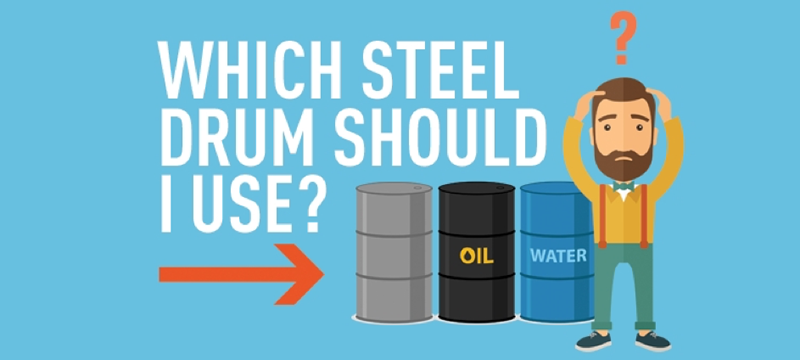|
【有問必答】頭大了!我該用哪個鋼桶?
文/三哥

許多工廠在生產過程中使用鋼桶。它們的使用方式千差萬別,就像它們所在的數千種制造工廠一樣。一些最常見的用途是大量儲存/運輸化學品和收集廢物(液體或固體)。它們接觸的液體和化學品是多種多樣的,它們的工作也會隨著你的工廠需求而變化,所以需要不同種類的桶來配合你的應用。但是你怎么知道你需要哪一個呢?
1、制造材料
大多數桶是由碳鋼或不銹鋼制成的。不銹鋼比碳鋼有更好的耐化學性。因此,如果你的工廠使用腐蝕性的化學品,或者如果有廣泛的液體可能接觸到的桶,不銹鋼桶將更多功能和處理更多的工作。鋼桶也可以內襯以增加耐腐蝕性能。
2、鋼板厚度
鋼板的厚度很重要,這取決于你使用鋼桶的原因。較厚的桶推薦用于運輸危險液體,因為它們比薄的桶更堅固。此外,桶越厚,它能承受的重量和壓力就越大。大多數鋼桶在描述桶的厚度時都是這樣的,1.5/1.2/1.2毫米,但這意味著什么呢?這顯示了桶蓋/桶體/桶底不同部位的厚度。在上面的例子中,這意味著蓋子是1.5毫米厚,桶身是1.2毫米厚,桶底是1.2毫米厚。大多數鋼桶的厚度在0.9 - 1.5毫米之間。
3、開口或者閉口
鋼桶的封閉器可以是開口的(蓋子可以拆卸),也可以是閉口的(蓋子是永久固定的)。開口桶通常用于頻繁添加或提取內容物的場合。開口桶使它更容易與固體和較濃的液體(土壤,吸收劑,糖漿,膠水,油等)工作,而閉口桶通常用于較低粘度的液體。

開口桶上的蓋子通常與螺母和螺栓環連接,可以緊固到特定的扭矩,以滿足聯合國額定值的要求。您還可以使用快速打開的杠桿鎖環,以方便打開和關閉,消除每次需要使用工具來拆卸蓋子。New Pig開發了一種獨特的鎖蓋系統,用戶可以用一只手打開和關閉一個開口桶,無需工具。鎖蓋系統是最方便,最簡單的方式打開鋼桶。
4、桶塞的類型
如果您打算使用漏斗向桶中灌裝液體,或者如果您打算用輸液泵配件,以便將液體從桶中直接泵入某個工序,您需要知道蓋子上的塞子(頂部開口)是什么類型的。一個閉口桶通常有兩個塞子,一個直徑為2英寸,一個直徑為3 / 4英寸。塞子上的螺紋幾乎總是NPT(國家管道錐度),但偶爾也可能是Buttress類型。NPT螺紋是細螺紋,而Buttress螺紋是粗螺紋。他們也有不同的結構風格,這可能需要一個專門的工具來擰緊。

與用于連接兩根管道的直管螺紋不同,npt螺紋連接件將拉緊,以形成液體密封。大多數鋼桶有npt螺紋塞子桶口和蓋。支撐螺紋也設計用于形成液體密封,但比NPT螺紋更大、更粗。支撐螺紋也被稱為“鋸齒螺紋”,設計用于處理高應力,如收緊塞子開口的漏斗。典型地螺紋開口和桶蓋是在塑料桶而不是鋼桶上應用的。
WHICH?STEEL?DRUM?SHOULD?I?USE ?
Many plants use?steel drums?in their processes. The way they are used is as varied as the thousands of types of manufacturing plants they are found in. Some of the most common uses are bulk storage/transport of chemicals and waste collection (liquid or solid). The liquids and chemicals they come in contact with are varied and the jobs they do change with your plant’s needs, so different kinds of drums are needed to match your application. But how do you know which one you need?
Construction Material
Most drums are made of either carbon steel or stainless steel. Stainless steel offers better chemical resistance than carbon steel. So, if your plant uses aggressive chemicals or if there is a wide range of liquids the drum may come in contact with, a stainless steel drum will be more versatile and handle more jobs. The drums can also be lined for added corrosion resistance.
Steel Thickness
The thickness of the metal is important depending on the reason you’re using a drum. Thicker drums are recommended for shipping hazardous liquids, as they’re stronger than thinner drums. Plus, the thicker the drum, the more weight and pressure it can handle. Most drums show something like this – 1.5/1.2/1.2 mm – when describing the thickness of the drum, but what does that mean? This shows the thickness of the different parts of the drum – lid/body/base. In the above example, that would mean that the lid is 1.5 mm thick, the body is 1.2 mm thick and the base is 1.2 mm thick. Most drums fall in the range of 0.9 – 1.5 mm thick.
Open or Closed Head
Drums are either open head (lid can be removed) or tight/closed head (lid is permanently secured). Open-head drums are typically used in situations where frequent addition or extraction of the contents occurs. Open-head drums make it easier to work with solids and thicker liquids (soils, absorbents, syrups, glues, oils, etc.) while tight-head drums are typically used with lower viscosity liquids.
The lid on an open-head drum is typically attached with a nut and bolt ring, which can be tightened to a particular torque to meet UN Rating requirements. You can also use quick-opening lever lock rings for easy access and closure, eliminating the need to use tools every time you want to remove the lid. New Pig has developed a unique latching lid system that enables users to open and close an open-head drum with?one hand?and?no tools. The?latching lid system?is the most convenient, easiest way to access your drum.
Bung Threading:
If you intend to use?funnels?to add liquids to your drum, or if you intend to add pump fittings for pumping liquids out of your drum directly into one of your processes, you will need to know what type of bung (top opening) is on the lid. A tight/closed-head drum would typically have 2 bungs, one 2” and one ?” in diameter. The threads on the bungs are almost always NPT (National Pipe Taper), but occasionally could be Buttress type instead. NPT threads are a fine thread and Buttress threads are a coarse thread. They also have different head styles, which may require a specialized tool for tightening.
Unlike straight pipe threading that is used to join two pieces of pipe together, NPT-threaded fittings will pull tight to make a liquid-tight seal. Most steel drums have NPT-threaded bung openings and caps. Buttress threads are also designed to form a liquid-tight seal, but are larger and coarser than NPT threads. Buttress threads are also known as “saw threads” and are designed to handle high stress, such as tightening a funnel into the bung opening. Typically, Buttress-threaded openings and caps are found on plastic drums rather than steel.
|

